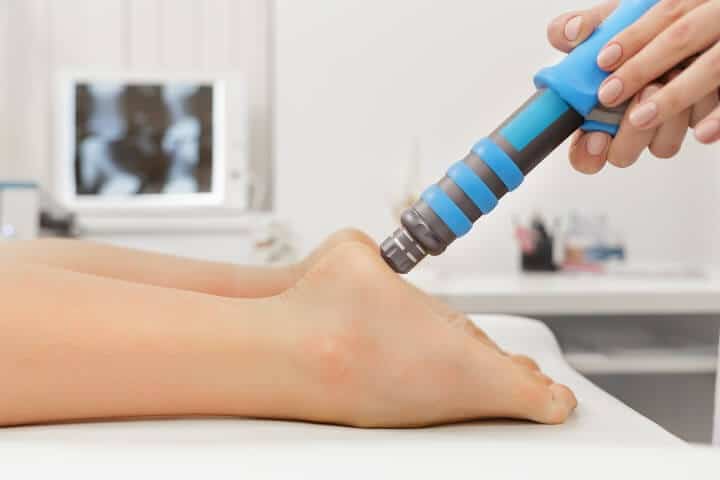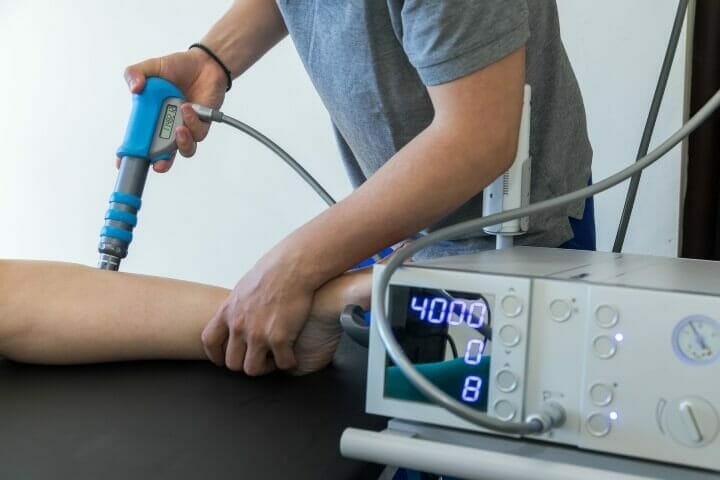Who doesn’t know the distress caused by painful soft-tissue conditions and aching bones? These are not only difficult to manage but more often than not, the person has to rely just on painkillers for long periods. With evolving medical sciences, new potential treatments are coming to the front.
One of them is shockwave therapy. Though a scary name, the treatment is non-painful and non-invasive! This article will take you through all that you need to know about the treatment and whether it will be covered by your insurance provider.
Many preconditions need to be satisfied for this therapy to get covered by insurance. So read on, to dig deeper.
Contents
What is Shockwave Therapy?
Also known as Extracorporeal Shockwave Therapy (ESWT), it has emerged as a potential non-invasive method of pain relief (extracorporeal meaning outside the body). It is used in painful musculoskeletal conditions as well as in chronic tendonitis (long-standing swollen tendons). It was originally developed in the late 1900s for urologists to treat kidney stones non-invasively.
How Does ESWT Work?
Through the ESWT machine, a shockwave is applied directly on the part of the skin that covers the injured part. Shockwave is a non-linear, special type of pressure wave. Pressure or sound waves are mechanical waves that oscillate and can travel through solid, liquid, and gas.
This short-lived pressure disturbance travels through the body in all three dimensions of space (length, breadth, and depth i.e. the X, Y, and Z-axis in terms of physical dimensions). This causes hyperstimulation of the injured tissue by the waves, which in turn leads to decreased transmission of pain signals from the injury site to the brain. This can promote the growth of small blood vessels for activating the healing mechanism and also restore the body’s natural nerve functions.
You might like to read Assisted Living Insurance Costs
The Different Kinds of ESWT
ESWT is of two types.
1. Focussed Shockwave Therapy (FSWT) – known so because the pressure field is focussed at a selected depth in the tissues for maximum pressure. This depth is adjustable. These waves are generated inside water in the source. These are better transferred to the body tissue as there is a reduced reflection of the wave.
2. Radial Shockwave Therapy (RSWT) – has a diverging pressure field so that the maximum pressure is at the source and not at the tissue depth. It is relatively new and has made ESWT more affordable. In this, an accelerated projectile hits an applicator which is at the end of a tube that has compressed air. This applicator thereafter conducts the generated pressure wave to the affected part of the body.
Is ESWT Painful?
Shockwave therapy is a non-invasive procedure and is not painful. Depending on the tolerance of the person, some may complain of mild discomfort due to the waves or the device rubbing against the skin, which is mild and insignificant. The process hardly lasts a few minutes and is well tolerated by the patient. It is advisable to wear loose clothing for the procedure for comfort.
Are There After-Effects After the Treatment?
No special preparation is required by the patient for the procedure and the patient can return home once the procedure is done. Though less frequent, there may be slight redness, tingling, numbness, or swelling in the area, which should subside in a day or two. The number of sessions of shockwave therapy and their frequency will be decided upon by the physician.
Which Are the Conditions That Shockwave Therapy Helps In Treating?
- Tennis elbow – this is the pain felt on the outer side of the elbow
- Golfer’s elbow – this is the name for the pain felt on the inner side of the elbow
- Plantar fasciitis – pain on the lower side of the foot
- Achilles tendinopathy – pain in tendons that connect the back of the foot to the calf muscles in the leg.
- ITBS (Iliotibial Band Syndrome) – this pain happens due to cycling or running, that travels from the hips to the outer side of thighs and finishes in the knees.
- Muscle tears
- Tendonitis (swelling in the tendons)
- Arthritis bone edema (fluid retention)
- Sports injuries
That being said, the success of the ESWT is still under debate as more studies are needed to confirm its results. Though biologically, it is effective, more literature needs to be obtained regarding its clinical effects.
You may also like to read Do Mobility Scooters Need Tax and Insurance
Contraindications of ESWT
Though it is a safe procedure, yet it may not be advised in a few cases.
- Pregnancy
- Any nervous system disorder
- History of bone/soft-tissue cancers
- Any bleeding disorders, or when a patient is on anti-clotting medicines.
- Any localized infection in the area of application of the shockwave therapy.
Usually, before starting the procedure, the physician takes a detailed history of the patient and advises whether the procedure is recommended or not for that particular patient. This is a standard protocol that must be followed at all times.
Coverage Under Insurance
A good shockwave therapy machine can cost upwards of a couple of hundred dollars. Sometimes they can be covered by insurance, though.
Medicare and Medicaid
The Centre for Medicare and Medicaid Services (CMS) does not have a National Coverage Determination (NCD) for Extracorporeal Shockwave therapy. NCD in the United States determines which services or devices are covered by it for costs. It will decide whether the item is necessary and reasonable for use for the patient. The notices for the same are released each year by the CMS.
Under Local Coverage Determination (LCD), CMS may give financial coverage to limited patients e.g. those with plantar fasciitis, only if all other conservative therapies have failed over the past 6 months and when it is presented as an alternative to surgery.
In the treatment of musculoskeletal conditions, shockwave therapy is not considered the primary treatment. It is adopted only when all other vigorous attempts at conservative treatments have been made and the only option left is surgery.
Some cases such as those of plantar fasciitis may be reimbursed but only where equipment approved by the FDA (Food and Drug Authority) has been used for treatment.
There are no standard costs of treatment for ESWT because of a large number of variable factors which differ with each disease and treatment. Hence, the cost of the treatment will depend greatly on the following :
- Type of treatment
- The number of sessions done
- Equipment used
- The treatment provider
- Any other accessory costs such as that for anesthesia (if needed)
For the same reason, most of the private insurance plans also do not cover shockwave therapy.
That being said, this treatment is less expensive than undergoing surgery. However, definitive costs regarding the costs of the treatment for various conditions cannot be determined accurately because of personal biases in the studies conducted so far.
The rate of a patient returning to work after the treatment will depend on not only his occupation but also the rules of the policies that cover him. But by and large, the costs of ESWT in Canada may run lower than in the US where they may range anywhere between USD 3000 and USD 7000.
Other Conservative (Non-Surgical) Treatment Options
Before finally going into surgery, one can explore these other options as well. These can be used either alone or in combination with shockwave therapy. These options are as follows:
- First and foremost the patient is advised to avoid doing anything that puts stress on the affected injured area. Avoid any activities of high impact which can potentially worsen the condition. Give the said area appropriate resting time.
- Using NSAIDs or Non-Steroidal Anti Inflammatory Drugs. They include all the medicines that act as painkillers and in various degrees reduce the other symptoms of injury such as inflammation (swelling), redness, and local increased heat in the area.
- They may have to be taken single, or in combination for short or long periods to alleviate the pain.
- Taping, which is a temporary measure to secure the area with tape to prevent it from moving.
- Casting, which involves the use of casts to immobilize the injured area and to support it.
- Applying Ice involves the local application of ice to bring down the swelling in the area.
- Using heel cups or pads to provide support to the heels and prevent them from high impact.
- Getting Physiotherapy, i,e. physical therapy by a qualified person to increase the range of movement of the area and to get it back to normal functioning.
- Shoe modifications, to provide adequate support to the foot.
- Night splints, wearing selective supportive splints at night.
- Steroid injections can be used in severe cases or when there is excruciating pain. In cases where nothing else may seem to work, the physician may recommend steroid injections.
- The use of Orthoses is another option. They are devices applied externally to the body to provide support and/or mechanically align the part of the body.
Precautions
- The patient must consult a physician and give a detailed medical history before undergoing ESWT.
- ESWT should be done following the legal and medical regulations of that country/state.
- Only those people competent medically i.e. do not have any contraindicating conditions to undergo the treatment, should go for it. (can you reword this one, its appearing that the patient needs to be competent medically)
- The following guidelines can be referred to for an idea of the process.
Finally, it can be summed up that shockwave therapy can be used as a method to treat various musculoskeletal conditions conservatively i.e. a non-surgical and non-invasive way. However, it is best to leave this judgment up to qualified physicians and specialists, and the treatments should not be done based on mere hearsay.
Also, before undergoing this treatment, it is always a good idea to check local insurance policies and regulations regarding coverage for your treatments to reduce the burden on one’s pocket. This form of physio care can be explored to get rid of various painful limiting conditions when no other options have seemed to work.




